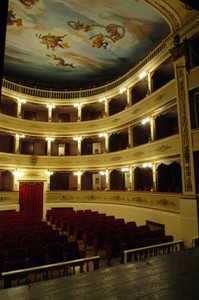Atri
| Informazioni |
|---|
| Mappa e contatti |
Towering beyond the Teramo seaside, this delightful town of great artistic interest has ancient origins going back to the VII-V century B.C. Important Roman colony, Atri was first subjected to Barbarian Invasions and to foreign powers during the Middle Ages and re-emerged only under the dominion of the Lords of Acquaviva.
Today the centre of this town continues to evoke strongly the charms of its great history. Monuments and historic palaces, churches, museums and suggestive corners are like the pieces of a splendid mosaic, which Atri offers to its numerous visitors.
Dating from 1285 and recently restored, the Cathedral of Santa Maria Assunta stands in Piazza Duomo. The four finely crafted portals date back to the XIII century while the inside is characterised by three naves, a square apse and series of wonderful frescos by Andrea de Litio, a fifteenth-century artist from Abruzzzo. In the adjoining museum are preserved precious relics: painted majolicas, crosses, gold and silver pastorals, illuminated manuscripts, statues and hundreds of mosaic pieces from ancient buildings. The cloister with two rows of arches and the bell tower completed in the XV century by Antonio da Lodi are also splendid.
Remaining on Piazza Duomo, the visitor will find on one side the Palazzo Mambelli with its arcades, and to the south the Palazzo Vescovile and the Seminario dating from the sixteenth century. Opposite the Cathedral stands the perfectly conserved nineteenth-century Teatro comunale. The façade of the little town theatre, also known as the “sweet box” because of its size (300 seats) and enviable acoustics, imitates the Scala Theatre in Milan while the inside was inspired by the “S.Carlo” of Naples and its three levels of boxes and loggias.
The magnificent Palazzo Ducale degli Acquaviva is today the seat of the City Hall. It is a sort of stone fortress, which was built in the early 14th century and transformed in the 18th century. The façade encloses a Renaissance courtyard surrounded by an arcaded loggia where Roman inscriptions and testimonies can still be admired.
Between art and nature, the enchanting characteristic furrows surrounding Atri, resulting from centuries of erosion of the clayey ground, seem to rise like “natural sculptures”. The severe tons and colours of an almost lunar scenery with its stately above soaring architecture of peculiar geological formations seem to evoke Dante's trenches.

















